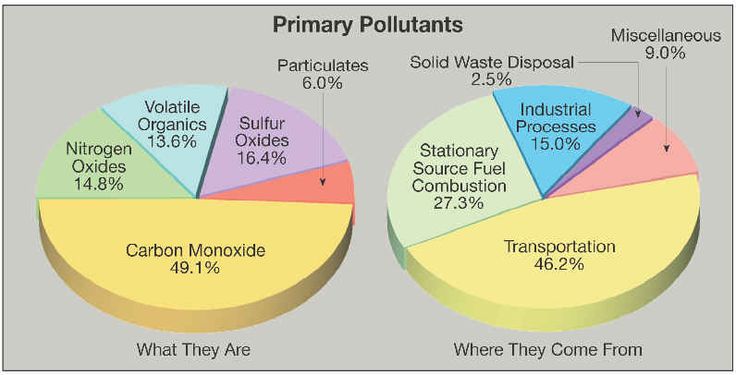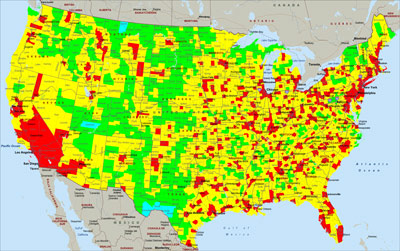The Balance: Pollution vs. Exercise

There’s nothing quite as invigorating – or quite as painful, I might say – as icy cold air in your lungs as your daily running, jogging or biking routine is forced to adapt to winter weather.
While the frigid temperatures this time of year may increase your awareness of your own breathing, the cold isn’t the only thing being sucked into your body. There are also a host of chemicals, toxins, pollutants, pollens and greenhouse gasses likely coursing through your lungs with every breath.

What's in a breath?
The particular mixture of pollutants in the air will vary of course, but the most typical components found will be Carbon Monoxide, Nitrogen Dioxide, Sulfur Dioxide, and other miscellaneous gasses, chemicals or particles including Lead, Arsenic and Asbestos.
Ozone is also created, when Nitrogen Oxides mix with volatile organic compounds in sunlight. Ozone is one of the major components of “smog”, and can cause a number of health problems when breathed regularly.
Between Ozone and other toxins that may be found in the air, higher concentrations of pollution can lead to potential health hazards as obvious as asthma and as deadly as cancer.
How bad is it where I live?
That depends – but statistically your odds aren’t particularly good. The American Lung Association sponsors a program called State of the Air, wherein individual counties across the United States are scored for air quality based on the number and type of pollutants found. As of 2015 data, 40% of Americans live in areas where the air quality has received an “F” rating.
If you live in Los Angeles, Fresno, Visalia, Sacramento, Bakersfield or San Diego in California, you’re breathing some of the worst rated air in the United States. It’s not all California, either – Charlotte, NC; Dallas, TX; Knoxville, TN and Scottsdale, AZ are among many others near the bottom of the air quality charts.

Click the image above for a high-resolution version
The news isn’t all bad. In America, the air is gradually getting cleaner according to the EPA. Toxins and pollutant emissions have been reduced by over 40% since the 1990’s. Lead pollution – perhaps the most dangerous toxin we’ve put into our atmosphere – has been especially affected, with levels reduced nearly 80% over a 20-year timeframe. In Europe, things are looking up as well. Sulfur Oxide pollution has gone down over 80% since the 90’s.
Exercise Outdoors - Is it worth the risk?
If the air outside is particularly bad, you might wonder – when do the risks of exercising in dirty air outweigh the benefits of the exercise?
If that sounds like a silly question, consider this: The World Health Organization estimates that 7 million people die every year from causes directly linked to air pollution. Worldwide, pollution-related deaths out-pace accidental deaths by automobile.
Further, your intake of pollutants from the air increases dramatically during exercise. This is because you breathe faster and deeper, pushing far more air through your lungs every minute.
A research study in 2014 sought some answers to the trade-off.
They approached the issue by conducting two studies. In the first study, researchers had human subjects perform cycling exercises. Half of the subjects exercised in a lab with exceptionally clean, filtered air. The other half exercised alongside a busy road with moderate pollutant levels.
Exercise in and of itself is known to improve brain health. A key element in this process is called Brain-Derived Neurotropic Factor, or BDNF. BDNF is a protein found in the brain, and is a member of the neurotrophic family of growth factors.
By default, the study subjects should have shown an increase in BDNF. The subjects cycling inside of the lab showed this improvement – but the test subjects breathing exhaust fumes on the side of a busy road did not.
The second study was longer-term. In this case, all of the subjects engaged in a 12-week training program. Some were located in an urban environment with higher levels of pollution, while the others performed the program in rural areas.
At the beginning and the conclusion of the study, participants were tested for brain executive function – that is, the working memory and problem solving abilities. The rural subjects improved after the exercise regimen, while the urban subjects did not.
The findings do indicate that a polluted environment tends to negate the mental acuity benefits of exercise – however there’s a lot more to the equation. While air pollution does kill over 4 million people per year, heart disease kills nearly 18 million and strokes kill 15 million. Both of these killers can often be directly attributed to a lack of exercise.
It’s also worth noting that a percentage of the air pollution related deaths recorded were attributed to indoor air conditions – as in factories, cooking areas or other enclosed places with inadequate ventilation. In other words, pollution is often an inescapable reality, whether you go outdoors or not.
The answer is complicated.
Beyond facts and figures on a global scale, you need to consider your location and your own body into the equation. If you have a history of asthma or other breathing problems, exercising in moderately polluted air might prove more difficult – or potentially even dangerous.
On high pollution days, older people or those with lung problems should certainly consider indoor alternatives in locations with reasonably cleaner air.
That said, experts agree that for the rest of us the physical benefits of exercise still outweigh the potential risks.
There are several ways to lower your exposure to pollution risks, too.
If possible, seeking out “green” areas for your outdoor exercise is recommended. This means looking for places lush with trees, bushes, shrubs and other plants, and away from heavily industrial locations.
Timing can be important as well. Ground-level ozone is usually highest in the mid to late-afternoon, so exercising in the mornings is often a better choice. Simply avoiding rush hour times can help significantly.
One option that actually doesn’t help as much as you might think, is filtration face masks. While face masks are excellent for keeping larger particulates out of your lungs like dust, they do little to protect you from the smaller particles and gasses and make up the most dangerous elements of air pollution.
Exercising indoors is an option – but air indoors can often be the same quality as air breathed through a face mask. Finding a gym or fitness center with adequate air filtration, or located in a less polluted area of town will definitely help.
Whatever you do, just remember – it could always be worse. You could live in Delhi right now.
How did we do?

Rated 4.1 of 5 Stars by 160 readers.


